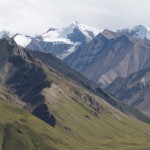On Monday, 13 June, Christchurch was again rocked by earthquakes that caused damages and left people injured. Three significant events happened within two hours. At 1:00 UTC a mb5.0 event occured, followed by a Mw6.0 at 2:20 UTC and a M4.6 at 2:40 UTC. The strongest event caused instrumental intensities of up to VII close to the city. Update: Geonet reports a magnitude of 6.3. more
Posts in the category » « ( 60 Posts )
-
Earthquake series hits Christchurch, NZ, causing liquefaction, landslides
2011-06-13 | in Uncategorized -
New paper: Alsop & Marco: Soft-Sediment deformation within seismogenic slumps of the Dead Sea Basin
2011-04-17 | in PaperSome days ago, a great new paper was published on the investigation of soft-sediment deformation in paleoseismology: “Alsop & Marco 2011: Soft-Sediment deformation within seismogenic slumps of the Dead Sea Basin. Journal of Structural Geology 33 (2011) 433-457.” The authors investigated the most beautiful seismites I’ve ever seen and generated different scenarios for their interpretation with respect to paleoseismic events. more
-
What’s up? The Friday links (9)
2011-03-25 | in The Friday LinksWhile the Japan earthquake has dominated the media obviously, some other news came up in geoscience. A researcher team lead by Ludovic Ferrierè who works at the Natural History Museum in Vienna claims to have proven the first impact crater in central Africa. The Luizi structure in the Democratic Republic of Congo was described in 1919 by a German study, but has not been confirmed as an impact crater for decades. Ferrierè and his team now found shatter cones and shocked quartzes, strongly pointing to an impact. The crater has a diameter of 17 km and a 350 m high rim, which led the scientists to assume a meteor of 1 km diameter and a velocity of ~20,000 m/s. more
-
SSA meeting: Special session on Japan, Christchurch EQs
2011-03-16 | in Japan EarthquakeThe Seismological Society of America has re-opened abstract submission for a special session on the Christchurch and Japan earthquakes during the Memphis conference. Deadline for new abstracts on this topic is 25 March.
The Seismological Society of America‘s annual meeting 2011 will take place in Memphis, Tennessee from 13 – 15 April. A special focus is set on the New Madrid earthquakes, so paleoseismologists will definitely hear some interesting sessions there. Post meeting excursions are scheduled 16 April. For more information visit the official website.
-
Why was the Christchurch earthquake so devastating?
2011-02-23 | in Teaching | 3 responsesA M6.3 earthquake hit Christchurch, New Zealand on 22 February (21 Feb in UTC), leaving at least 75 people dead and hundreds injured or missing. Hundreds of houses were destroyed, including the Christchurch Cathedral, and damages will probably sum up to some billion dollars. On 4 September 2010 (3 Sept in UTC), a M7.0 event struck Christchurch, but then no one was killed. So: what’s the difference between the two events?
-
What’s up? The Friday links (6)
2011-02-11 | in The Friday LinksToday on Friday, 11 February, a magnitude 7.0 earthquake occurred offshore in Chile near Concepcion at 36.5° S and 73° W in a depth of 28km. The MMI at the nearby large cities was reported by the USGS with V.
Update: The magnitude was corrected to 6.8. The earthquake was followed one hour later by a further event with a magnitude of 5.3 and 4 hours later again by a more shallow 6.3.
more -
Job Openings: Five research geologists, tectonics for USGS Alaska
2011-01-27 | in Uncategorized The Alaska Science Center is advertising five new permanent research geologist positions. Applications are open between December 1, 2010 and February 15, 2011, and that selection will occur during late spring of 2011. More information on their homepage, including the following announcement:
The Alaska Science Center is advertising five new permanent research geologist positions. Applications are open between December 1, 2010 and February 15, 2011, and that selection will occur during late spring of 2011. More information on their homepage, including the following announcement:“This hiring initiative inaugurates a team approach to geologic research in Alaska (Photo gallery). The five positions will together make up a working group that will respond to the USGS’ ongoing need for research in framework geology of the 49th state. Project work is expected to support a broad range of research topics related to crustal evolution and surficial processes. We expect projects will involve collaboration with researchers from other USGS offices, federal agencies, state agencies, and academia.
more
